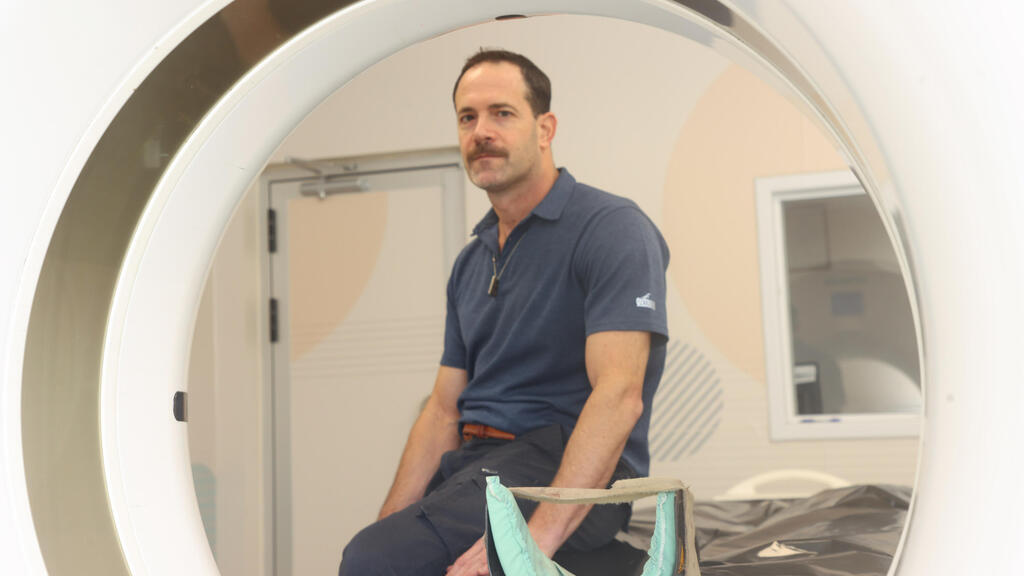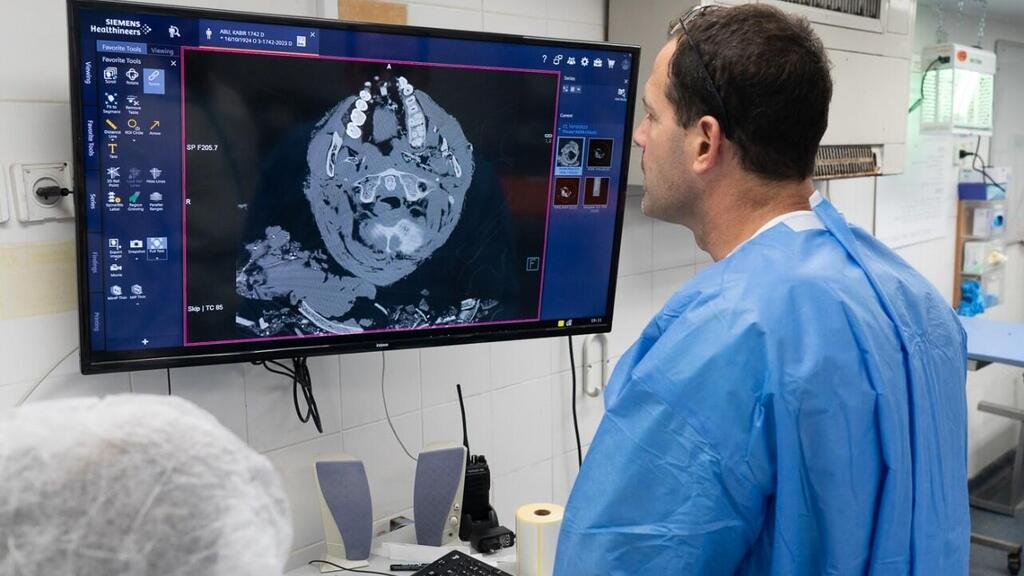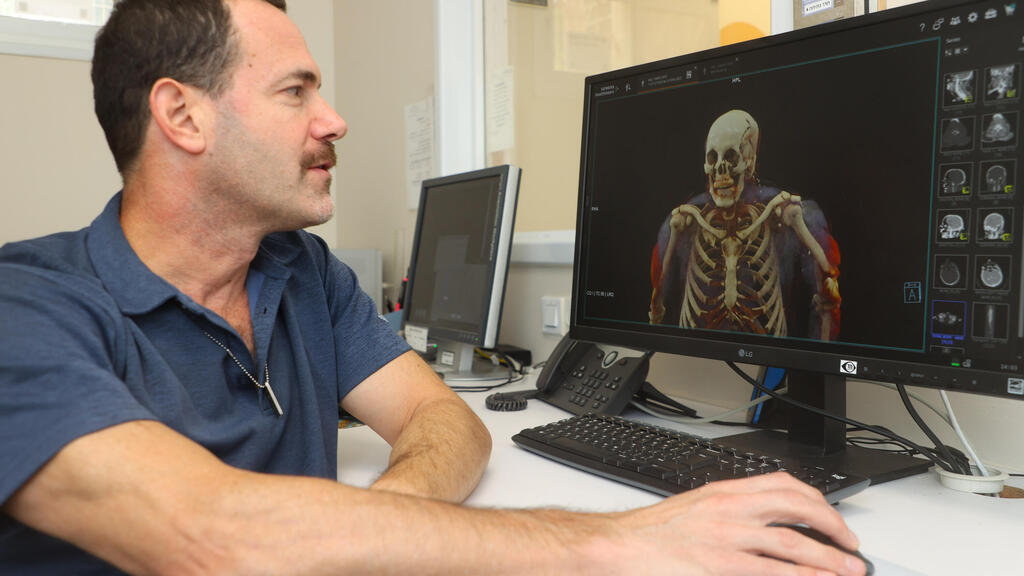In a tremendous and unprecedented effort in Israeli history, the National Institute for Forensic Medicine has worked around the clock for weeks to identify the bodies that came from the many massacre sites on October 7. Dr. Alon Krispin, Head of Forensic Radiology at the National Institute of Forensic Medicine, led the radiological identification process together with dozens of volunteer doctors. They performed CT scans for each body that arrived and made a manual comparison with previous medical imaging of the missing people.
Read more:
In those very days, academic experts led by Prof. Ilan Tsarfaty, an imaging and cancer research expert at Tel Aviv University, began to develop a groundbreaking artificial intelligence technology for body identification which can do in just a few minutes what dozens of doctors did for days.
5 View gallery
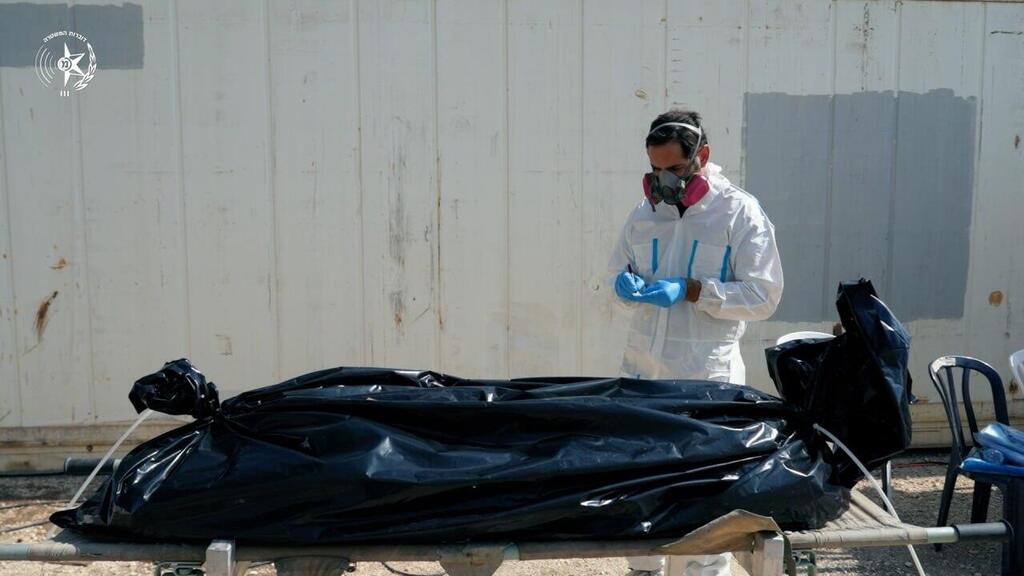

Shura camp where bodies of the victims of the Hamas massacre were brought
(Photo: Israel police)
The technology, which started as a "family project", with the help of Prof. Tsarfaty's relatives and other dedicated volunteers, has already been tested with success that exceeds all expectations, but has not yet come into use.
No one in the National Institute, or in Israel as a whole, has expected an event on the scale of October 7. "This put us in one big mess, in anticipation of an unknown number of hostages, missing and murdered," said Dr. Krispin. "At first they talked about hundreds of people, because it was not clear how many there were. It started with 600, the next day it rose to 700, then to 1,000 and in the end, we reached more than 1,400 murdered, missing and those whose status was unknown."
The identification method through comparison of medical imaging is done in parallel with other methods that involve database, such as DNA testing, fingerprints, and comparison of dentition (the structure of the teeth).
When performing a manual comparison with medical imaging tests, there is a need to reduce the tens of thousands of potential comparisons and direct the test to an assumed identity which is then compared to the anonymous body at the Institute of Forensic Medicine. On the other hand, methods that use database, allow to identify a missing person automatically, if that persons' data was previously entered into the database.
In order to reduce the number of comparisons, the Institute of Forensic Medicine performed CT scans of the bodies that came from the various massacre sites and looked for unique features in the skeleton that do not change after death.
"The CT scans allowed us to see, among other things, who had a pacemaker, who had undergone an open-heart surgery, who had electrodes in the skull, and who had a hip replacement," said Dr. Krispin. "Then we went through the list of the missing and their ante-mortem medical imaging record, trying to locate the ones who had these unique features. This is how we reduced the number of comparisons required for each body."
Still, the National institute for Forensic Medicine had many comparisons to make. Dr. Ran Mashraki at the Beilinson Medical Center recruited a team of 40 radiologists, most of them experts in the field, who volunteered to assist in performing manual comparison of CT scans from before and after death. At the same time, another team of volunteers led by Dr. Shoham Baruch processed information emerging from the CT scans and extracted data for comparison purposes. The teams worked in shifts around the clock for about two weeks, they created images of the relevant areas in the skeleton to be compared, made manual comparisons, and identified the bodies.
"This is a challenging work, you smell everything and see trucks unloading dozens of bodies – it's difficult to contain such an event," said Dr. Mashraki. "A work of this magnitude has never been done in the world. In the past we used to compare a dead body to one missing person, here we had hundreds of dead bodies versus hundreds of missing people, and we had no idea who was murdered and who was kidnapped. In addition, among the bodies there were also those of terrorists, and we didn't even know they were terrorists,", he adds.
All that was left of the body, was a small bone from the nape near the ear
"We went through thousands of medical imaging and huge amounts of information," added Dr. Mashraki. He pointed out that many cases were even more complex because some of the bodies were mutilated. "Some of the bodies arrived headless, and many bodies arrived as ashes with bone remnants, and we had to identify them on the basis of tiny bone fragments. We helped to identify people who were not identified by the database methods. In fact, we dealt with the most difficult cases of victims who were not identified in any other way. At the end of each identification, we felt a sense of relief, realizing that we were providing some answers to the families and helping to reduce the endless cycle of the missing."
But despite the many hours of work, during two weeks of examining the most horrifying cases, the team of radiologists identified 11 bodies through manual comparisons. "At a certain point the bodies became so difficult to identify, because they were either burned or missing parts of bones, so we were left with no relevant data," said Dr. Krispin.
The last identification made by the team was of a single bone measuring two centimeters by three centimeters. "We had a single completely charred bone from the nape near the ear, and we realized that it probably came from the house of a specific missing person. It was not possible to perform a DNA testing at this stage, there are of course no fingerprints and no teeth. All that remained of the body was that bone, so we had no other choice but to address the team of radiologists," said Dr. Krispin.
"The volunteering in the country was amazing. People came and worked here 16 hours a day - getting nothing in return. This is Israel at its best, and I can't imagine anything so powerful happening anywhere else in the world," Krispin says. "It's simply amazing and I'm grateful to everyone who came and contributed to this effort. Of course, we have to thank the National Institute of Forensic Medicine and the Ministry of Health for making this possible by quickly establishing a broad infrastructure system that supported everything that happened here."
"Amazing abilities in less than 100 days"
At the same time, Prof. Ilan Tsarfaty, an imaging and cancer research expert at Tel Aviv University, began to develop a unique Israeli technology that could make the body identification task quick and automatic. He turned to Dr. Krispin, and together with Prof. Aviv Metzer at the Hebrew University, they developed the artificial intelligence technology to identify bodies, which is based on machine learning; it performs an automatic comparison of up to 117 skeletal parts between postmortem CT scans (PM) of the deceased and their ante-mortem scans (AM) which were collected in health institutions across the country.
The technology, which is still in development and in the experimental stage, will enable a large-scale identification without the need for additional data. This development has significant implications for public health, especially in mass casualty events where accurate, rapid identification is essential. In addition, the system will also help in other cases, including natural deaths and cases of rotted and burned bodies.
Prof. Tsarfaty describes how the idea was born: "I arrived at the Institute of Forensic Medicine and couldn't believe my eyes. I saw dozens of radiologists doing sacred work, comparing bone to bone, but I was devastated by the sight of the mutilated bodies, and I immediately realized that it was impossible to keep on working that way." He added that for many years he has developed a method for comparing tumor developments using medical imaging tests and said that "the method could be applied also to compare different bones."
Using existing technology for cancer research to identify bodies of victims
The very next day Prof. Tsarfaty presented an organized work plan to develop a system that would turn the cancer research technology into body identification research. "It started as a family project. Me, my wife, my son and two daughters. Then my son-in-law joined us, and we started recruiting more people," he said. "It was unbelievable. More than 80 volunteers joined us in an effort to develop a system that would allow us to compare between a body and a missing person within a few minutes.
5 View gallery
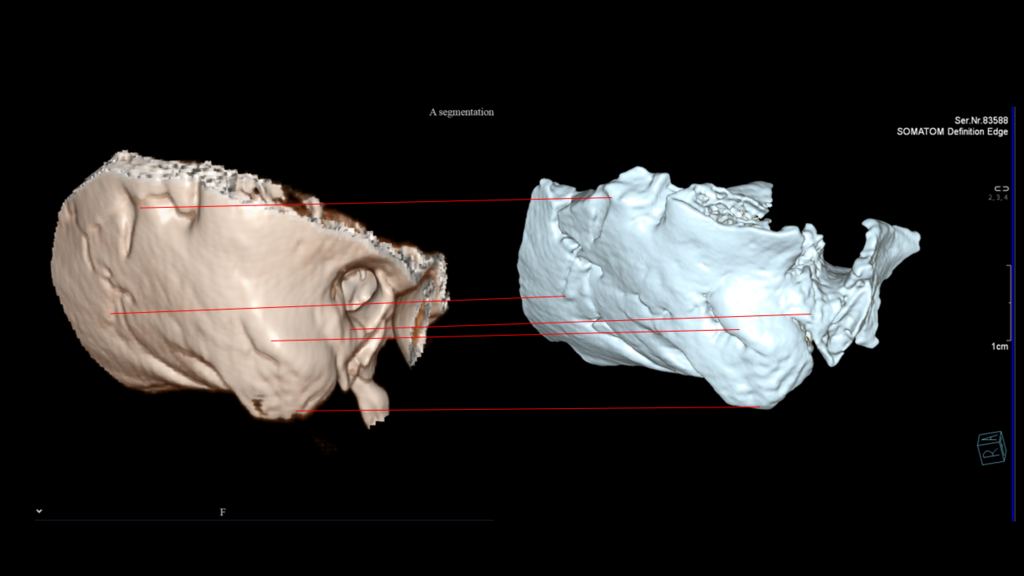

Comparing bone fragments to existing CT images on record in order to identify victims of the Hamas massacre
"At a certain point, Minister of Science, Innovation and Technology, Ofir Akunis heard about the project, and asked us to present it to him," Prof. Tsarfaty said. "In our presentation I told him that we were working incorrectly. The correct way was to make use of all the different methods altogether, including DNA, fingerprints, and dental structure. Then we started working on it, and today we are cooperating with forensic labs and all the relevant experts in order to establish an outline for the development of all the different methods."
Prof. Tsarfaty also expresses his gratitude to Amazon and the Ministry of Health: "Without their help, we would not have been able to carry out the task." The goal is to create a technology that would include all identification methods under one cloud, he said. "Thus, using the AI4VI method - artificial intelligence for victim identification, will enable to identify quickly and with the least effort, more victims in the future, such as bodies that would be returned from the Gaza Strip, or in cases of earthquakes." He referred to the difficult cases of burnt corpses or bodies that had undergone severe corruption, and added: "In such cases, the DNA is weak, the teeth are distorted, the CT scan is unclear and there are no fingerprints. When you use all the identification methods together, it's like putting the pieces of a puzzle together, enabling to reach identification at a much higher level."
Development of the ambitious technology is still underway today, in cooperation with high-tech and artificial intelligence companies, and it is in the experimental stage. Unlike the various forensic methods, the technology would not be based on a local server database but rather on a secure cloud storage, which will make it possible to view the measurements, comparisons and matching performed between a body and the missing person directly and automatically. So far, the technology was tested on bodies transferred from the National Institute for Forensic Medicine. "The results are very promising," Krispin said.
"The revolutionary method synthesizes results from many parts of the skeleton, which means that if, for example, the body lacks a spine, but it has a part of the palm, or a single bone from another area in the body - a comparison can still be made," explained Dr. Krispin. "It's amazing how quickly these developments happened. In less than 100 days the technology reached amazing capabilities. Such things usually take decades to develop."
According to Dr. Krispin's vision, "a secure cloud would be established to store all imaging tests performed in Israel, and thus there will be an ante-mortem database of everyone who has ever been tested. In such case, all you need to do is scan the body, and the computer will come up with automatic comparison results. Of course, this can help in both small and large scale cases."
"The system also identifies vertebras that were burned, shot and blown up"
In the dark days that followed the terrorist attack, Dr. Krispin was also approached by the CEO of RTC Vision, Dr. Yossi Rubner, who in collaboration with Mazor-Medtronic established another technology that compares vertebrae of different spines. The technology is based on their existing software which is intended for planning spinal surgeries, and they have adapted it so it can examine and compare different spines, and produce a "score" according to the degree of the matching.
System found all the matches very quickly and with a 100% success rate,
Unlike the manual comparison where you compare one image to another, this system knows how to compare one image to many other images. "An experiment showed that the system found all the matches very quickly and with a 100% success rate," said Dr. Krispin. "Even when degenerative changes occurred in the body, the system was still able to make an identification. It's amazing to see that even in cases where some of the vertebras were burned, shot, blown up or fractured - the system was still able to identify similar parts that remained."
Dr. Rubner said that the technology came into use only a few weeks after the October 7 attack, because it was necessary to obtain appropriate authorizations; therefore, it was not tested on the many bodies that arrived at the Institute of Forensic Medicine at that time. "Our technology that helps doctors plan spinal surgeries exists for many years now, and when the war broke out, we realized that many bodies were in bad shape and that our technology can help. The technology knew how to match each victim to a missing person using CT scans the victim had previously performed or using x-ray images such as chest x-rays.
"Some of the bodies were in a bad condition, with only bones remaining, and we were also able to match their scans," said Dr. Rubner. "The test we performed was based on cases where bodies had already been identified, and our technology was used as an additional verification step. Our system performed about 18 matches. There are now preparations for return of bodies scenarios, and our technology is ready to assist at the touch of a button. But I hope we won't need this technology in the future.
"This is a unique technology that exists nowhere else in the world," added Dr. Rubner. However, he noted that "at this stage we are not planning to turn it into a dedicated system for such cases. But we will make it available whenever it can be useful and to those who need it. Right now, we are focusing on surviving the war and providing help."


